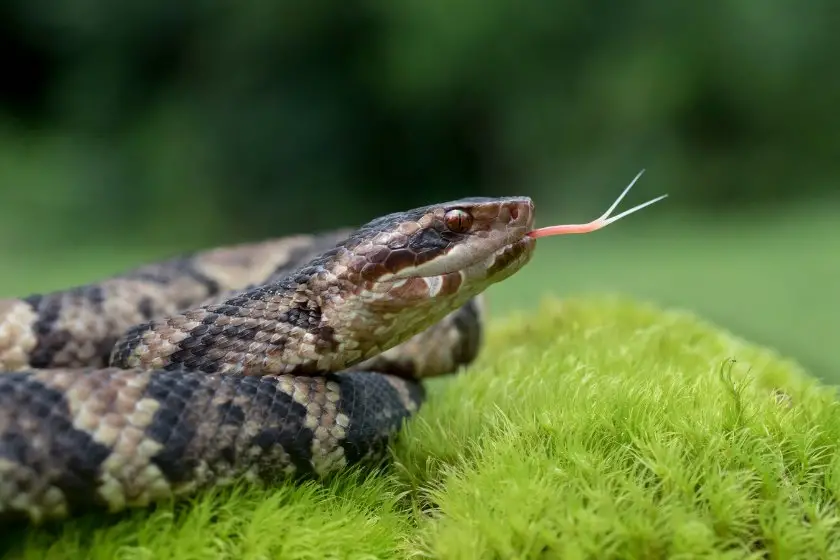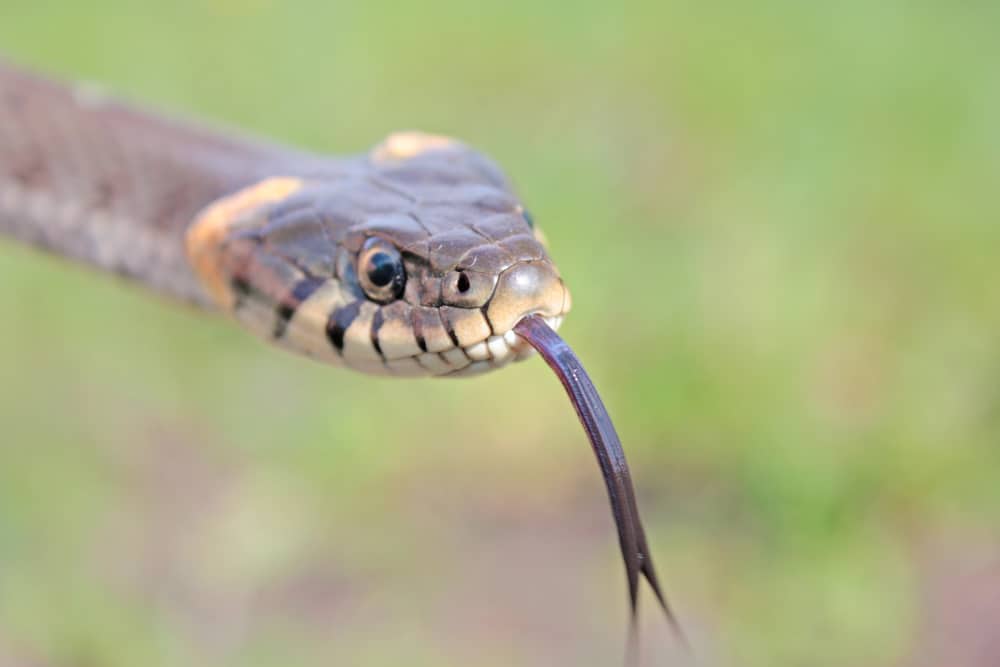Did you know that even without a vocal cord, snakes are able to communicate with each other and the world around them using a lot of different sounds?
From hissing to rattling and even buzzing sounds, every noise a snake makes has a specific function that helps these creatures survive in the wild. These sounds aid communication with other creatures, predators and prey alike and serve as a warning signal to approaching animals.
In this article, we’ll delve into the exciting world of snake noises and learn the mysteries behind their buzzing, hissing, growling, and rattling noises. So if you’re eager to learn more about these reptiles’ secret language, join us in exploring the serpentine realm of snake noises.
Why Do Snakes Make Different Sounds?
Contrary to popular misconception, it will interest you that not every snake noise indicates danger. Snakes make many different noises to communicate with one another and other creatures.
From research, it’s been discovered that there are ample reasons why snakes make different noises. They might use loud, high-pitched noises to frighten predators; this will buy them the time they need to flee or get ready for a fight.
Snakes also use some sounds to attract the attention of potential mates. For instance, the male garter snake would combine pheromones with particular calls to entice a female during mating season.
Therefore, although snakes are often associated with their silent slithering, they have a sophisticated and varied language of sounds they employ for interaction. Every snake sound has a specific function and contributes to the safety and survival of these amazing animals in their environment.
8 Sounds Snakes Make and Why They Make them
From the warning hisses of a cornered snake to the enticing buzzes of a male looking for a mate, each type of noise has a purpose and plays a vital role in the snake’s life cycle. Here are eight common noises a snake makes and what they mean.
1. Hissing Sounds to Frighten Predators
Snakes can adapt and survive in various conditions because of their effective hissing defense mechanism. Like a superhero’s battle cry, the sound of a snake’s hiss conveys to any possible prey or approaching predator that it should back down.
The hiss is produced when air is forced through a partially closed glottis. It is a universal warning signal that many animals find frightening and know it is better to keep their distance from the direction where the sound is being produced.
Depending on the circumstance, a snake’s hiss might differ significantly between species and even within the same species. While snakes like the bull snake have a more subtle hiss, other non-venomous snakes, like the pine snake, can make an ear-piercing hissing sound.
2. Rattling Noises As a Warning Sound
A sequence of interconnecting segments makes up a snake’s rattle, which, when shaken, makes a buzzing, rattling noise. This sound allows the snake to draw attention and buy some time to strike or flee.
However, when dealing with some snake species, the rattle could mean more than just a cry for caution, as some snake species use rattling sounds to draw partners. During mating season, male rattlesnakes fight with one another for the attention of females by using their rattles to lure them. They also use this highly developed method of communication to interact with other animals, humans, and even their surroundings. For instance, a snake’s rattle can send various messages, including information about the snake’s size, age, and level of hostility.
N.B: The rattling sound is not peculiar to rattlesnakes alone, as other species, like the gopher snake, imitate this sound to scare predators.
3. Popping Sounds For Defense Against Predators
This popping sound is peculiar and frequently characterized as a series of popping or cracking noises. This is an intriguing adaptation that serves different purposes to snakes, one of which is to defend itself from possible predators.
When a snake senses that it is being threatened or cornered, some snake species, like the hog-nosed snake and the Sonoran coral snake, may make a loud noise known as cloacal popping.
This noise, usually used by these small snakes, serves as a way to scare their assailant and give the snake time to flee. The loud popping noise is achieved by the snake rapidly expelling air from its lungs.
In addition to being used as a defensive mechanism, popping sounds created by snakes are used for communicating. For example, many female snake species can create popping noises to entice a partner or let other snakes know they are ready to mate.
Lastly, some snakes’ popping sounds may also contribute to thermoregulation. Snakes can control their body temperature and keep cool in hot conditions by rapidly expelling air from their lungs.
4. Whistling Sounds to Warn predators And Attract Mates

You might be surprised to learn that some snake species are known for their distinctive whistling sound, which serves a huge purpose in the snake community. Whistling is a means of communication and is often used by male snakes to entice a partner or let other snakes know they are ready to mate.
Notwithstanding, some snakes use whistling as a warning signal. When frightened or trapped, several snake species may create a whistling sound to warn their assailant that they are very dangerous.
Typical snake species that whistle frequently include Russell’s vipers, corn snakes, and ball pythons.
Finally, if a shred of skin becomes lodged around the nose cavity when a snake is shedding, that snake may whistle until it comes off.
5. Buzzing Sounds to Navigate Their Surroundings And Defend Themselves
When a snake like the king cobra buzzes, it vibrates the scales on its underside. This vibration produces a low-frequency hum that the snake uses to communicate and warn off potential predators.
Although the precise purpose of some snakes’ buzzing sounds remains unknown, these reptiles are believed to use to mark territorial boundaries, attract partners, and alarm predators.
Consequently, it is not surprising to see snakes use buzzing noises to aid in navigating at night since these buzzes cause vibrations that allow them to feel their surroundings.
6. Growling Noises For Defense And to Mimic Other Creatures
To scare possible predators off, snakes are known to let off a low, guttural growl when they feel threatened. This growl is made by the snake vibrating its neck muscles.
Some snake species, such as rattlesnakes, sometimes imitate sounds other predators make with their growls to frighten away predators. Additionally, snakes can survive through mimicry, a trait that helps snakes avoid direct conflict with possible predators.
N.B: Not all snake species can make growling noises.
7. Rasping Sound During Courtship and Aggression
In courtship or hostility, snakes commonly communicate by making rasping sounds. A typical example is the saw-scaled vipers that produce this scratching noise by rubbing their scales against one another when threatened.
Also, in rare situations, females will retort with their rasping noises in response to the males’ use of this sound to attract mates.
Snakes, like cobras, may also emit rasping noises to terrify adversaries during combative engagements to warn other snakes that it is prepared to defend themselves, which may assist in avoiding violent encounters.
8. Shrieking Sounds to Discourage Attack From Other Animals
Believe it when we tell you that snakes make shrieking noises as a defense strategy when they perceive a threat.
To make this sound, the snake rapidly flexes its body muscles, which results in a harsh, high-pitched noise. This sound intends to send a strong message to other nearby animals that the snake is prepared to defend itself, frighten predators, and discourage them from trying to attack.
In some snake species, the shrieking sound can imitate the cries of birds or other animals, which might aid the snake in warding off predators or luring mates. In addition, as a form of mimicry, this special trick enables the snake to avoid direct conflict with prospective predators.
Here’s how a snake’s shriek sounds.
Final Thoughts
In conclusion, the sounds made by snakes are an exceedingly fascinating component of their activity and means of survival. Each sound a snake makes, whether it be a low-frequency buzzing sound, a guttural growl, a harsh rasping sound, or a high-pitched shriek, has a specific function in its daily life.
The idea that such basic vibrations and sounds may be so important to an animal’s ability to survive in the wild is astonishing. Therefore, pay great attention when you next encounter a snake; you might experience the fantastic world of snake noises firsthand.
